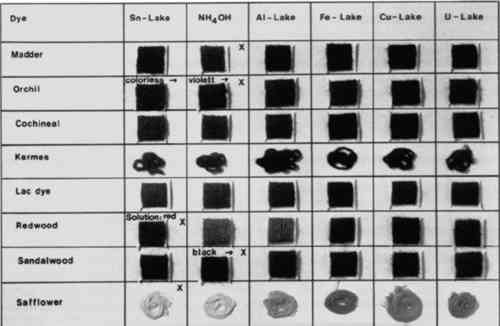IDENTIFICATION OF DYES ON OLD TEXTILES
Helmut Schweppe
6 RED
FIGURE 3 shows the lakes of the most important red natural dyes: madder (the most commonly-encountered natural red dye), orchil, cochineal, kermes, lac dye, redwood, sandalwood, and safflower. Madder can be recognized by its orange tin lake. Orchil can be identified with certainty by its failure to form colored lakes with tin and the intense violet formed on subsequent treatment with ammonia. Redwood can be recognized by the intense red solution formed when the material is treated with stannous chloride reagent. Sandalwood can be recognized by the change from red to almost black when the tin lake is treated with ammonia and the reversion to red when the ammonia is washed out by water. Safflower dyeings are bleached by treatment with stannous chloride, and remain colorless when subsequently treated with ammonia. Cochineal, kermes, and lac dye cannot be distinguished by means of their lakes; here it is necessary to make use of thin-layer chromatography.
Fig. 3.
Lakes of red natural dyes.
 |
|
